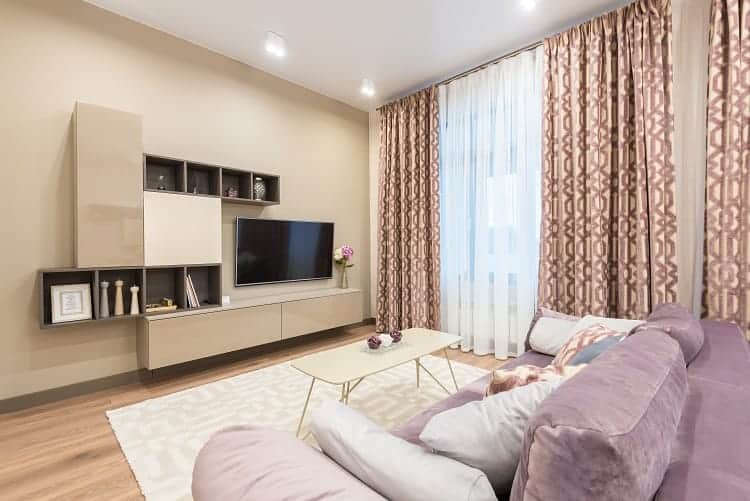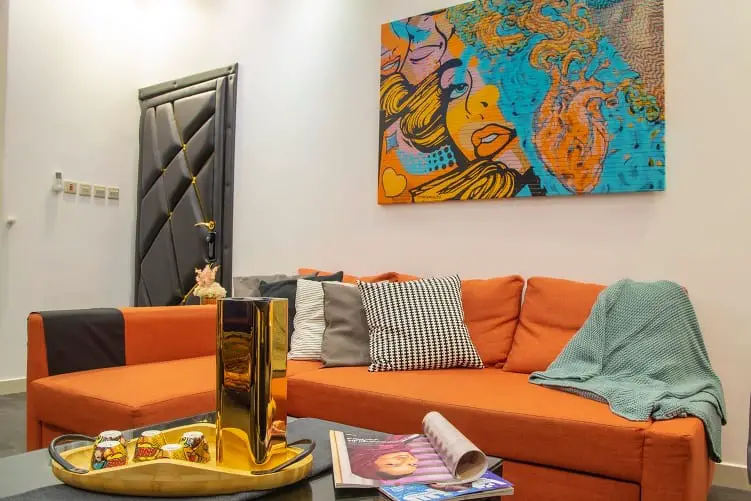Does outside noise keep you up at night or distract you from completing work? Are you tired of feeling like you live in the middle of a busy intersection? Fear not, because there are plenty of budget-friendly ways to soundproof your room and create a peaceful oasis amid the chaos.
First up, let’s talk about the power of curtains. Not only can they add a pop of color and style to your space, but they can also help block out outside noise. Opt for thick, heavy curtains of dense fabrics like velvet or suede to absorb sound waves and create a more serene atmosphere.
Another simple yet effective way to reduce outside noise is to fill any gaps or cracks in your walls and windows. Weatherstripping or caulk can seal any openings and prevent sound waves from seeping through. This will not only help with noise reduction but can also improve insulation and energy efficiency.
If you want to take things to the next level, consider adding soft surfaces to your space. This could include area rugs, carpets, or blankets draped over chairs or couches. These soft surfaces will help absorb sound waves and reduce echoes, creating a more peaceful and comfortable environment.
And finally, don’t underestimate the power of a bookshelf. It will add some personality to your space, and a bookshelf filled with books can help absorb sound waves and reduce outside noise.
By implementing these simple and effective strategies, you can enjoy a more serene environment free from outside noise. So let’s dive into the world of soundproofing and learn how to make your home a more peaceful place to live.
Why is sound so difficult to contain?

Do you ever feel like living in a fishbowl, where every sound from the outside seems to seep into your space? Trying to block out noise from the world around us can be frustrating and overwhelming, and you may wonder why it’s so difficult to contain sound.
The truth is sound waves are incredibly powerful and difficult to control. They can travel through almost any medium, including walls, ceilings, and floors, and can bounce around a space, creating echoes and reverberations that can make even small noises seem louder than they are.
One of the main challenges of soundproofing a space is finding ways to absorb or deflect these sound waves. This can involve using dense materials like concrete or soundproof foam panels to block sound from entering or exiting a space. It can also involve adding soft surfaces like carpets or curtains to absorb sound waves and reduce echoes.
Another challenge is dealing with the nature of sound itself. Unlike light or other types of energy, sound waves are omnidirectional, meaning they travel in all directions at once. This can make it difficult to contain or control sound, as it can bounce off surfaces and travel unexpectedly.
Despite the challenges, many ways exist to soundproof space and reduce outside noise. There are plenty of tricks to try, from using heavy curtains and sealing wall gaps to adding soft surfaces and soundproof foam panels. So the next time you struggle to contain sound in your space, remember that you’re not alone and that you can create a more peaceful and serene environment with a little effort and ingenuity.
Read More How To Paint A Room |DIY Pro Tips
Where is the sound coming from?
Do you feel like living in a rock concert whenever you try to relax at home? Are the sound of traffic, barking dogs, and chatty neighbors driving you crazy? It can be frustrating and confusing to try and figure out where outside noise is coming from and how to block it out.
Identifying the source of outside noise is the first step in soundproofing a space. Is it coming from a nearby construction site, a busy road, or a neighbor’s party? Once you’ve identified the source, you can think about ways to block or absorb the sound.
One of the most common sources of outside noise is traffic. Cars and trucks passing by can create a lot of noise, especially if you live on a busy street. To reduce the sound of traffic, consider using soundproof curtains or installing double-paned windows. These can help block out the noise and create a more peaceful environment.
You may need to get creative if the sound comes from a nearby construction site. Heavy blankets or mattresses against walls can help absorb sound waves and reduce echoes. You could also try using earplugs or noise-canceling headphones to block the noise.
Sometimes, the source of outside noise can be more elusive. For example, if you live in an apartment building, you may hear noise from your neighbors above or below you. In this case, using soundproof foam panels on your ceiling or adding a thick rug to your floor can help absorb sound waves and reduce the amount of noise between floors.
Identifying the source of outside noise is key to soundproofing a space. There are plenty of tricks to try, whether it’s traffic, construction, or noisy neighbors. So the next time you struggle to block out outside noise, take a moment to identify the source and get creative with your soundproofing solutions.
Four Basic Principles for Soundproofing a Room
How to soundproof a room will depend on first knowing the four basic principles of soundproofing a room from outside noise.
For example, if your bedroom is next to a busy road or train track, you may want to soundproof a room from outside noise.
Or perhaps you need a home office to soundproof for security reasons.
These include:
Airtight and dense walls
If you want to block noise from entering your house, you’d better thicken the walls with dense and heavy materials.
This is because moving a heavy object is hard; thus, adding an extra layer of mass onto walls helps soundproof your room.
You can do it yourself by adding a cupboard or a bookshelf and lining it with voluminous books. Alternatively, you can buy soundproofing materials or insulate your walls.
Sealing and increasing the mass of the wall
Sealing all gaps in your room blocks external noise from getting into your room.
Therefore, ensure that you seal any cracks in your windows, doors, and walls to make your soundproofing project successful.
Sound travels by air, so any gap that can let in the air can allow noise penetration. Ensure you’ve sealed all holes and cracks, especially in windows and doors.
Decoupling
Decoupling is the process of separating different surfaces such that walls, ceilings, and floors are not in touch with anything that allows vibrations to pass through.
Most people tend to use resilient channels as they use up sound energy allowing minimal sound to make it to the walls or ceiling.
Decoupling walls helps prevent vibration from moving from one room to the next, and that’s why many people use drywall and wooden studs to avoid vibrations from traveling from one room to the next.
Using soft materials to absorb the noise
After soundproofing and ensuring that no outside noise can enter your room, the next step is dealing with the noise inside the room.
Since sound waves bounce off the walls, you must line your room and ceiling with absorbent materials so that they can absorb the noise.
Soft and absorbent materials trap the sound waves, making them lose energy.
Some of the most famous soft, porous materials for lining your room include acoustic foam and fabric soundproofing panels.
You can also use paintings, tapestries, and other fabric materials.
Investing in noise cancellation systems
You can buy noise cancellation systems such as the ANC (active noise cancellation).
They are considered to be high-tech soundproofing solutions.
The device works by producing its noise opposite to the one coming into the room, and as a result, the two cancel out each other resulting in a quiet room.
This technology is pretty expensive and is best suited for noise coming from home appliances in your house.
However, the device has a challenge canceling out noise from outside.
Factors to Look Out for When Soundproofing Your Room
Soundproofing your room isn’t as complicated as people make it.
This is because you can soundproof your space by rearranging the furniture.
However, you should know what to look for when assessing your home before soundproofing.
Some of the things to watch out for include the following:
- The source of the noise or sound: Once you know the type of noise you are dealing with, you’ll be better equipped to deal with it.
- Where it is getting in from: Once you know the entry point, you will know whether to add an extra wall mass, seal the gaps and cracks or decouple your room.
- The reflection: If it is reflected after noise penetration in your room, you’d better consider soundproofing techniques where you soundproof your headboard and footboard walls.
The most common soundproofing methods include:
Various methods and materials can be used to soundproof a space, each with pros and cons. Here are some of the most common soundproofing methods:
- Soundproof curtains are thick, thick curtains that absorb sound waves and reduce echoes. They can be hung over windows or used to partition off a space.
- Acoustic foam panels are lightweight foam panels designed to absorb sound waves and reduce echoes. They can be attached to walls, ceilings, or floors.
- Mass-loaded vinyl: This is a dense, flexible material used to line walls or ceilings. It blocks sound from entering or exiting a space.
- Double-paned windows: These are windows with two layers of glass, separated by a layer of air. This creates a barrier that blocks outside noise from entering a space.
- Weatherstripping: This material strip can seal gaps around doors and windows. It prevents outside noise from entering a space through these gaps.
- Carpeting: Adding a thick carpet to a space can help absorb sound waves and reduce echoes.
- Drywall: Using thicker, denser drywall can help block sound from entering or exiting a space.
- Door sweeps: These are strips of material that can be attached to the bottom of doors to seal gaps and prevent noise from entering a space.
- Seal gaps and cracks: Inspect the room for any gaps or cracks in the walls, windows, and doors. Use caulk or weatherstripping to seal these openings. This will help reduce the amount of noise that can get in.
- Cover hard surfaces: Hard surfaces like walls and floors can reflect sound waves, making the room more echoey. Covering these surfaces with soft materials like area rugs, carpets, and blankets can help absorb sound and reduce outside noise.
- Use a bookshelf: A bookshelf filled with books can help absorb sound waves and reduce outside noise. Place the bookshelf against the wall that faces the source of the noise.
It’s worth noting that no single method is guaranteed to soundproof a space completely. Instead, a combination of methods may be necessary to achieve the desired level of sound reduction. Additionally, the effectiveness of these methods can vary depending on the source and frequency of the noise, as well as the layout and construction of the space.
5 Effective ways How To Soundproof a Room Cheaply: {Best methods for dampening outside noise}
Regardless of your room’s soundproofing, road noise, and noisy neighbors can be distracting.
Before you make this final decision, here are some other cheap techniques to prevent noise from reaching you.
These include:
1. Rearrange your furniture

This is the cheapest and most effective form of DIY soundproofing.
Ensure that all the heaviest pieces are arranged in one room, ensuring that your room has extra mass to prevent noise.
If you ever moved into a new house with little to no furniture, you’ve probably noticed that the room has many echoes.
Therefore, filling your space with furniture helps block the noise.
Some of the furniture that will help you soundproof the room include bookcases, tables, sofas, and wardrobes.
Apart from adding mass to the room, the furniture dampens and absorbs the noise, ensuring no echoes or reverberations bounce back.
Read More Best Non-Slip Staircase Treads
2. Place carpets and rugs on the floor

Most people living in urban areas, especially in apartments, take soundproofing very seriously.
Most prioritize soundproofing the walls and floorboards.
Not only does this block out noise, but it also prevents echoes through insulation
Most of the noise traveling via the floorboards is impact noise, and it is the most common type of noise.
It cannot be enjoyable for light sleepers.
To deal with it, consider covering every inch of your floor with heavy rugs and carpets that are cost-friendly.
The heavier the rugs and carpets, the more effective in reducing and absorbing the sound.
You can use rugs if you live in a rented apartment, but installing a carpet is much better if it’s your own house.
It’s considered an added advantage if you place an underlay underneath the carpet or rug.
It acts as a heat insulator and adds more mass to the room, thus improving soundproofing.
The benefit of this is that underlays are pretty cheap, and one layer is enough.
Read More Can Wash Rugs In The Washing Machine
3. Use door seals
Noise can leak in through the space under the door.
Therefore, you must seal the gap under your door to keep noise out of the room.
One of the most popular door seals includes acoustic sealant tape.
It can be used at the bottom or top part of your door.
The benefit of this is that they are cheap and are designed to mold themselves into the gap.
Alternatively, you can use metal or rubber seals; they also absorb the noise apart from providing mass.
When shopping for door seals, consider the following:
- Will the seal fill the gap?
- Will the door function normally?
- Do you need to seal the bottom and top parts of your door?
- How heavy are your doors, and is it feasible to replace them?
Read More How You Can Stop A Door From Slamming
4. Add acoustic to your walls and windows
Cracks in the walls and windows are another source of noise pollution.
You can easily soundproof your walls and windows by using acoustic sealants.
The good thing is that it is flexible and rubbery, which will not prevent you from opening the windows.
When buying acoustic sealants, ensure that they are water-based.
This is because they are easier to use and less smelly.
Although they are made of chemicals, ensure they do not affect the surface they contact.
Choose a sealant that can be painted to avoid altering your room’s aesthetics.
Not only does acoustic sealant prevent noise entry, but it also helps dampen sound waves and add mass, thus improving soundproofing.
5. Cost-friendly soundproof curtains

Curtains are great for keeping peeping toms outside.
Similarly, they can be used for soundproofing as they dampen the sounds.
So make sure to hang thick and densely woven curtains to help absorb external noise.
They are also effective in blocking out light.
To get the most out of your curtains, get ones that are bigger than your window.
Also, ensure that the rods are positioned a few inches above the window and have a larger frame. Ensure that the curtain is long to cover the bottom and more comprehensive to cover the sides.
The extra curtain fabric helps trap noise from the outside from entering through the window, and the rods will prevent the material from reflecting sound waves.
Instead, it diffuses and absorbs it.
Soundproof curtains have different shades on the inside and outside; the outer part is often dark.
Related Best Blackout Soundproof Curtains For Your Home, Office, Or Studio
What is the cheapest way to soundproof a wall?
One of the cheapest ways to soundproof a wall is to use blankets or thick curtains. Hang them over the wall, covering as much surface area as possible. This will help absorb sound waves and reduce echoes, making your space quieter.
Another inexpensive option is to use egg cartons or acoustic foam tiles. These can be attached to the wall using adhesive strips or glue. While they may not be the most attractive solution, they effectively absorb sound waves and reduce noise.
If you want a more permanent solution, consider using mass-loaded vinyl. This dense, flexible material can be attached to the wall using adhesive. It blocks sound from entering or exiting a space and is relatively inexpensive compared to other soundproofing materials.
Another cheap option is to use soundproof paint. While it may not be as effective as other soundproofing methods, it can help absorb sound waves and reduce noise. Plus, it’s easy to apply and can be painted over to match your existing decor.
Soundproofing a wall doesn’t have to be expensive. There are plenty of cheap and effective solutions to reduce the amount of noise that enters your space. So the next time you struggle to block out outside noise, try these cheap and cheerful methods.
Final Thoughts How To Soundproof a Room Cheaply
In conclusion, soundproofing a room doesn’t have to cost a fortune. There are plenty of affordable and effective solutions to reduce outside noise and create a more peaceful space. There are options for every budget and preference, from using blankets and thick curtains to mass-loaded vinyl and soundproof paint.
It’s important to remember that soundproofing can also depend on the type of noise you’re trying to block out. If you’re dealing with low-frequency noise, like traffic or construction, you may need to use more heavy-duty materials like drywall or soundproofing insulation. But the solutions mentioned above should do the trick for general noise reduction.
It’s also worth noting that soundproofing can be a DIY project, but it’s important to take safety precautions and ensure the materials you’re using are appropriate for your space. If you’re unsure, it’s always best to consult with a professional.
Soundproofing can greatly improve your quality of life and provide a more comfortable living space. So don’t let the outside noise get the best of you. Try some of these cheap and effective soundproofing methods and enjoy the peace and quiet you deserve.
